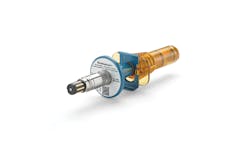Seriously stable single-use pH sensor
Plastic might not seem more capable than steel, but single-use bioreactor bags beat stainless-steel vessels hands down. This is because plastic containers for fermenting biopharmaceuticals don't require the lengthy, costly cleaning, sanitizing and setup time required by their metallic predecessors. In fact, the single-use renaissance in biopharmaceuticals is revising how basic production equipment and entire facilities are designed in favor of single-use and more modular processes.
There's just one snag. Single-use bioreactors can't tolerate penetrations by tubes, connectors, instruments and sensors because traditional, reusable hardware must be laboriously sanitized to avoid contamination. Unfortunately, though many single-use accessories are integrated into the bags, single-use liquid sensors remain less stable than their traditional counterparts. This is usually because their pH glass electrode membranes dry out in storage, causing their signals to drift and hindering accuracy, and because they can't cope with the gamma radiation sanitizing process used with most single-use bioreactors—until now.
Emerson Automation Solutions has released the Rosemount 550pH Single-Use Sensor that can achieve less than 0.005 pH change per day or 0.035 pH change per week in a worst-case scenario, compared to similar, autoclaved pH sensors that typically only reach 0.071 pH change per day or 0.05 to 0.1 pH change per week. Rosemount 550pH also features up to two years of shelf life from date of manufacture; maximum pressure up to 2 bar; USP Class VI, ISO 10093 and ADI-free compliant wetted materials; and material selection based on lowest achievable extraction profiles, which are performed in accordance with Biophorum Operations Group (BPOG) guidelines that are available when ordering. The sensor easily installs into 1-in. barb fittings on single-use bioreactors and can begin measuring immediately with no time needed to wet its glass for a stable measurement. It also ensures functionality before filling the bioreactor with a true, one-point standardization against a fully traceable storage solution.
"We cover a lot of industries such as oil and gas, chemical and life sciences, so we already had stainless-steel, steam-sterilized pH sensors," says Brandon Haschke, senior product engineer in the Rosemount division of Emerson Automation Solutions. "However, as single-use batch applications increased, we wanted to create a sensor that could bring the accuracy and reliability of traditional pH sensors to those single-use processes, integrate with their bags, and handle gamma radiation sterilization.
"550pH achieves greater stability because of its wet-storage capacity that keeps its pH glass membrane in just 2 mL of a pharmaceutical-grade, close-to-pH-neutral phosphate buffer solution during its entire storage life, which ensures healthier measurements and reduces setup time. Our buffer has been tested in small-scale batches and didn't affect viable cell count or titer of the end product. Other single-use sensors use dry storage, which means their pH glass membranes need to be in solution for 30-120 minutes before they can measure and makes them less stable and accurate."
Because users can be sure the pH of the buffer solution won't change over time, Haschke reports they can be confident when punching in their millivolts-per-pH sensor performance slope numbers during setup that the measurements they'll send to the analyzer will be within the right accuracy window. "This is the source of 550pH's accuracy," says Haschke. "If its accuracy is ±0.1 pH and stays constant, then the sensor will only drift by 0.005 per day or 0.035 per week."
The other primary talent of 550pH is that its components can successfully withstand the gamma-spectrum radiation that will blast the whole single-use assembly to kill any bio-burden. "Many substances can't stand gamma radiation and will get damaged and break like plastics left out in the sun for too long," adds Haschke. "So we picked stable materials for 550pH that can handle acid and base conditions from 2 pH to 12 pH, maintain their same polymer structure before and after sterilization, and go through the gamma radiation without any extractable substances getting into the bioreactor process."
For more information, visit Emerson.com/Rosemount550pH.

